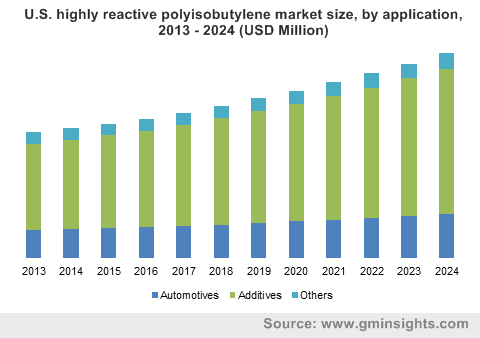Home > Chemicals & Materials > Polymers > Industrial Polymers > Highly Reactive Polyisobutylene (HR-PIB) Market
Highly Reactive Polyisobutylene (HR-PIB) Market Analysis
- Report ID: GMI2233
- Published Date: Nov 2017
- Report Format: PDF
Highly Reactive Polyisobutylene Market Analysis
Low molecular weight for highly reactive polyisobutylene market size attained the highest industry share and is anticipated to grow at a CAGR close to 4.5% in the near future. This is majorly due to its primary application is as a reactionary intermediate such as lubricant additive manufacturing. Low molecular weight HR-PIB viscosity is approximately 225 mm2/s at 100°C. Additionally, it possesses various other value-added advantages including less char production during manufacturing and ability to improve final lubricant and fuel performance.
Highly reactive polyisobutylene market size for additive is anticipated to grow at a CAGR close to 5% in the coming years. This is chiefly due to product’s detergent properties which reduce hydrocarbon and particulate emission when added to fuel. Rising need for lower emission fuels is likely to further augment product demand which in turn will help attain promising gains to highly reactive polyisobutylene market size in the coming years. It is added in small amounts to lubricating oils to help reduce oil mist generation and offer improved final product performance to the consumer and better manufacturing economics for the additive supplier.
North America highly reactive polyisobutylene market size is projected to grow at a CAGR of over 4.5% during the forecast period. This is majorly due to strong growth in the automotive, construction and medical packaging industry. Product possesses excellent features including chemical resistance and low permeability to air, moisture and gases. Henceforth, it is preferred in manufacturing a range of medical packaging applications such as serum vials, injectables, saline bottles and seals which will make noteworthy contribution to highly reactive polyisobutylene market size over the projected timespan. Product’s impermeable nature makes it preferable for manufacturing tubeless tires in automotive industry. However, product is majorly used as a fuel and lubricant additive to improve the overall performance owing to its highly reactive nature compared to conventional polyisobutylene which will make significant contribution to highly reactive polyisobutylene market size in the coming years.

